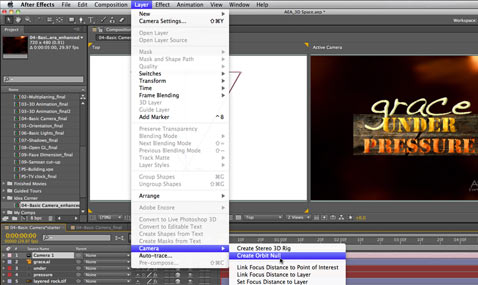As we mentioned earlier, we've been busy this year creating an extensive, multi-course video training series based on our popular beginner's book After Effects Apprentice. Each course has two or more movies that are free for all to view; we're re-posting those videos here on PVC to make sure you don't miss them. This movie demonstrates how to build an orbit camera rig in After Effects, both manually and by using the new menu command added in AE CS5.5.
The eleventh Apprentice course – based on Lesson 08 from the book of the same name – is a beginner-level introduction to 3D space inside Adobe After Effects. If you've never worked in 3D before, we build up your knowledge base step-by-step explaining what's different between 2D and 3D, then moving through cameras and lights – including how to build camera rigs and manage shadows. Once you've become familiar with those bedrock skills, we then demonstrate several different workflows for creating 3D objects inside Adobe Photoshop and importing them in After Effects. A set of sidebar movies at the end share additional tips on the difference between 3D rotation and orientation, using the different Axis Modes, and how to maintain maximum quality in 3D.
The movie above demonstrates how to build an orbit camera rig. Creating a perfect orbit around an object or other point of interest using ordinary motion paths for the camera requires careful placement of Position keyframes and tugging on Bezier path handles. Using the Orbit Camera tool in After Effects gives the illusion of creating a perfect arc, but in reality it just defines the end points of the path – not the path in between. However, there is a very useful trick where you can place a null object at your point of interest, parent the camera to the null, and use the null to swing the camera around on the end of a virtual string in a perfect arc. In this movie we demonstrate how to do this manually, as well as take advantage of a nifty new feature added in After Effects CS5.5 to do it manually. Subsequent movies in the same course then show how to expand this rig by adding elevator and tilt functions.
We've written about creating After Effects camera rigs in the past, including creating orbit rigs and more complex dolly rigs. We also created videos earlier this year on the new orbit camera rig command in After Effects CS5.5, as well as CS5.5's new stereoscopic camera rig.
By the way, we're happy to announce that in addition to lynda.com's excellent subscription service (where the above video came from), our book publisher Focal Press has now made the After Effects Apprentice video courses available for individual purchase through a partnership with Class on Demand. This particular course – at just under 3.5 hours in length – is only $14.95, including access to the exercise files. They are currently running a promotion where you receive the first Apprentice course (an overview of the program and user interface) for free with the purchase of any other Apprentice course – just use the code AEA1FREE. Enjoy!
FTC Disclosure: We make a bit of money whenever you purchase one of our courses from Class on Demand, or have a lynda.com subscription and watch one of our courses. We do not make any money from either when you watch these free videos. We've worked with Adobe over the years, and they give us free access to their software in exchange for testing and consulting, but they did not subsidize the creation of these videos or the book they are derived from. We're just trying to pay the bills by sharing what we've learned from using After Effects in the real world since version 1.0.
The content contained in After Effects Apprentice – as well as the CMG Blogs and CMG Keyframes posts on ProVideoCoalition – are copyright Crish Design, except where otherwise attributed.

Filmtools
Filmmakers go-to destination for pre-production, production & post production equipment!
Shop Now













